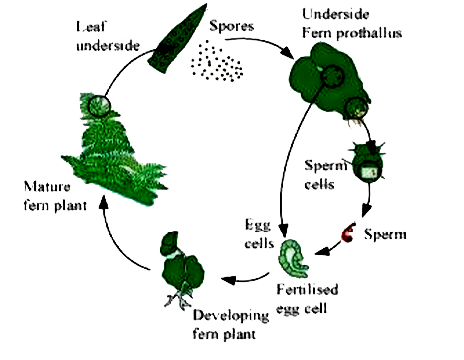Archegonium is the female sex organ that produces the female gamete or egg. It is present in the life cycles of bryophytes, pteridophytes, and gymnosperms.
Text Solution
Archegonium is the female sex organ that produces the female gamete or egg. It is present in the life cycles of bryophytes, pteridophytes, and gymnosperms.
Life cycle of a fern (Dryopteris)
Dryopteris is a common fern with pinnately-compound leaves. The main plant-body is sporophytic. Many sporangia are borne on the lower surfaces of its mature leaves. Each sporangium has spore mother cells which undergo meiosis to produce haploid spores. On maturing, these spores dehisce and germinate to give rise to a heartshaped gametophyte called prothallus.
The prothallus bears the male and female sex organs called antheridia and archegonia respectively. The antheridia produce sperms that swim in water to reach the archegonia. The egg is produced by the archegonia. As a result of fertilisation, a zygote is formed. The zygote forms an embryo, which in turn develops into a new sporophyte. The young plant comes out of the archegonium of the parent gametophyte.

|
Topper's Solved these Questions
Similar Questions
Knowledge Check
The life cycle pattern in pteridophytes and gymnosperms is :
AHaplo-diplontic in bodhBDiplo-haplontic and diplontic respectivelyCHaplontic and diplontic respectivelyDDiplontic and haplontic respectivelyWhich is the female sex organ in a flower?
APistilBStamenCCarpelDboth 1 and 3Female sex organs of bryophytes are called
AOogoniaBAscogoniaCArchaegoniaDAntheridia.
